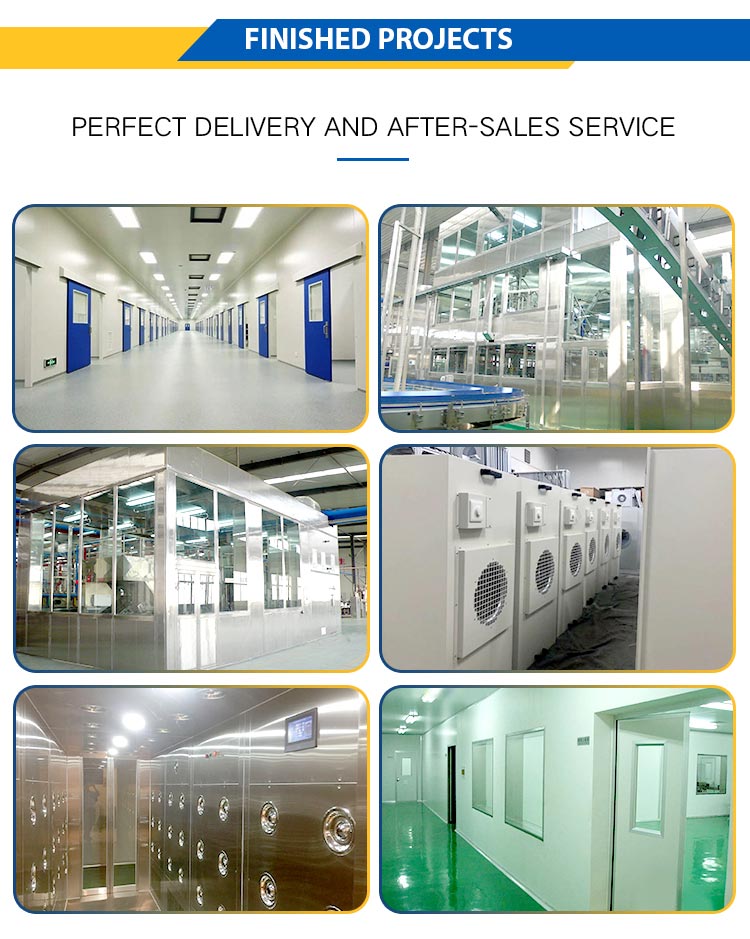The development of dust-free workshop is closely related to modern industry and cutting-edge technology. At present, it is widely used in biopharmaceutical, medical and health care, food daily chemical, electronic optics, energy, precision instruments and other industries.

Dust-free workshop air filtration system:
Adopt the new three-stage filtration of air filtration system, namely: fresh air three-stage filtration (coarse, medium and sub-high efficiency filtration); Intermediate filtration; Unend higher education filter. The air flow organization is more scientific and reasonable (can increase the life of the surface cooler, medium effect filter and high efficiency filter about 1O times). The medium effect filter bag screw fixation of the purification air conditioning system (not easy to disassemble and assemble) is changed to compression spring fixation, which is convenient for the management personnel to remove and wash regularly.
In order to demonstrate that the dust-free workshop works satisfactorily, it must be demonstrated that it meets the requirements of the following criteria:
1. The air supply volume of dust-free workshop is sufficient to dilute or eliminate indoor pollution.
2. The air in the dust-free workshop flows from the clean area to the area with poor cleanliness, and the flow of polluted air reaches the lowest degree. The flow direction of air at the door and in the indoor building is correct.
3. Air supply in dust-free workshop will not significantly increase indoor pollution.
4. The movement state of indoor air in dust-free workshop can ensure that there is no high concentration area in the chamber.
If the cleanroom meets the requirements of these guidelines, its particle concentration or microbial concentration can be measured (if necessary) to determine that it meets the specified cleanroom standards.
Test of dust-free workshop:
1. Air supply and exhaust volume: If it is a turbulent clean room, it is necessary to measure the air supply and exhaust volume. If it is a unidirectional flow clean room, the wind speed should be measured.
2. Flow control between zones: In order to prove that the flow direction between zones is correct, that is, from the clean zone to the area with poor cleanliness, it must be detected: (1) the pressure difference between zones is correct; (2) The airflow movement direction at the opening at the door or the wall and the floor is correct, that is, it flows from the clean area to the area with poor cleanliness.
3. Filter leak detection: the HEPA filter and its outer frame should be inspected to ensure that the suspended pollutants will not pass through: (1) the damaged filter; (2) the gap between the filter and its outer frame; (3) other parts of the filter device invade the room.
4. Isolation leak detection: This test is to prove that suspended contaminants do not penetrate the building material into the clean room.
5. Indoor air flow control: The type of air flow control test depends on the air flow pattern in the cleanroom - whether it is turbulent or unidirectional. If the air flow in the clean room is turbulent, it is necessary to verify that there is no area where the air flow is insufficient. If the one-way flow clean room, it is necessary to verify that the wind speed and direction of the whole room are in line with the design requirements.
6. Suspended PARTICLE CONCENTRATION and MICROBIAL concentration: If these tests meet the requirements, the particle concentration and microbial concentration (as needed) are finally measured to verify that they meet the technical requirements of the clean room design.
7. Other tests: In addition to the pollution control tests described above, one or more of the following tests may sometimes be necessary:
Temperature - relative humidity - indoor heating and cooling capacity - Noise value - illumination value - vibration value.